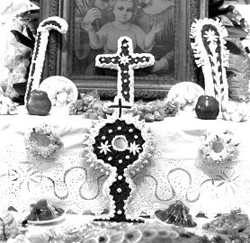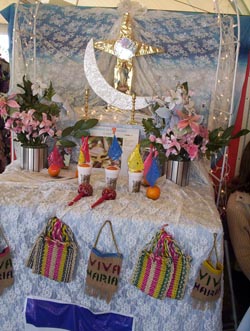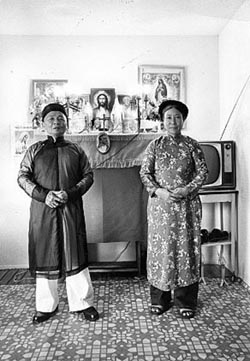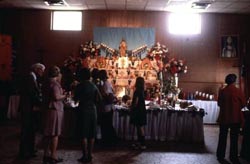Ritual Spaces in Traditional Louisiana Communities: Italian, Nicaraguan, and Vietnamese Altars
By Carolyn Ware
What do "lucky" fava beans, a woven magnolia leaf, and Nicaraguan "angels" have in common? All are parts of ritual traditions among different ethnic groups in Louisiana. Ritual traditions are among the richest of folk traditions, reflecting what is most valued and important in a culture. They may be religious or secular, solemn or festive, or a combination of all of these. But all transform ordinary places and time into something extraordinary, if only for a few hours.
Creating special sacred places in the home for worship and prayer is a common folk religious practice, especially in traditional Catholic communities. Home altars are a common sight in primarily Catholic French Louisiana, where a corner of a living room or bedroom is transformed into a small altar with a crucifix, holy cards, pictures or statues of saints and other decorations. Often a woven magnolia leaf or palm blessed on Palm Sunday hangs above a doorway. Building domestic altars has long been a family ritual among Cajuns and Black Creoles, and the Anon. Breaux manuscript describes a typical late 19th century Cajun home altar as "a statue of the Virgin, perhaps Our Lady of Lourdes, resting on an altar placed on a shelf near which hang a rosary and holy-water font" surrounded by "large and brightly-colored prints, among them the family's patron saints, the Wedding of the Blessed Virgin, the Consolatrix of All Affliction, the Good Shepherd, model of solicitude, carrying on his shoulders the injured sheep."
Many of today's Cajun and Black Creole families continue to keep home altars much like the one described. The importance of family, a central value of French Louisiana culture, is evident in the placement of family pictures near the altar, and the altar serves as a memorial to family members who have died as well as a place of prayer. Death announcements and personal tokens sit side by side with the holy pictures and candles on the altar. These serve as gentle reminders of spirituality in a secular world and are not considered to hold powers as is frequently misunderstood by non-Catholics.
Nicaraguan immigrants in the New Orleans area demonstrate their devotion to the Blessed Mother, the patron saint of Nicaragua, with small private altars in their homes. Blanca Keisling says of her mother's bedroom altar which holds a crucifix, a rosary, and statues of the Blessed Mother and St. Joseph: "It's like a church. We all do this. In my room it's like that too." In Nicaraguan families, as in Louisiana French homes, it is mostly the women of the family who keep the altars, "and the husband doesn't complain," Blanca explains.
Home worship and domestic altars are also important family traditions among Louisiana's Catholic Vietnamese immigrants, who share a special reverence for the Blessed Virgin and a strong belief in the importance of family values. In the area of New Orleans known as "Little Saigon," prayers are said together by the entire family several times a day. As Jesse Nash describes in Vietnamese Catholicism, the typical Catholic Vietnamese home in New Orleans will have at least one corner displaying statues of the Blessed Mother and Jesus, candles, crucifixes, flowers, and often paintings or smaller statues of the Holy Family or other saints. Frequently other areas of the house such as the dining room are also set up as places of worship, with their own statues and religious artifacts. Nearby hang Chinese-style scroll paintings and landscapes of Southeast Asian scenes, which like the refugees' traditional devotion to the Virgin, reflect their continuing Vietnamese identity in a new homeland.

Religious feast days are often celebrated by temporarily transforming homes, yards, or public halls into elaborate festive altars in honor of a patron saint. The Italian American St. Joseph altar, very popular in the New Orleans area and other communities with strong Italian American traditions, is perhaps Louisiana's best known example of a festive altar. Sicilian immigrants to New Orleans in the 19th century brought with them the custom of an altar for St. Joseph, the patron saint of Sicily. The most common explanation about the origin of the altars is that Sicilian farmers in the past prayed to St. Joseph for relief from a famine. When the famine ended, they offered thanks by building food altars in his honor on March 19, the feast of St. Joseph. Today, families often begin a tradition of annual altars to St. Joseph in gratitude for answered requests or favors. As this home-based tradition has become more popular and altars have become larger, some communities have moved their St. Joseph altars to church halls or other public halls, where members of the church or cultural organizations work together to prepare them.
St. Joseph traditions vary somewhat from community to community and even from family to family. The altar, often given on the eve and day of the feast of St. Joseph, is commonly built on three levels to represent the Holy Trinity. The three steps are covered with cloth and then abundantly filled with religious pictures and statues, fresh flowers, candles, and traditional Italian foods.
All of the foods, which include no meat but several seafood dishes, have traditional and symbolic importance. A variety of breads baked in shapes of crosses, shepherds' staffs, and lambs are displayed and later, after being blessed, pieces are offered to visitors. Sweets include a number of Italian cookies and especially the pignolata or "pinecone cake" of fried dough and melted sugar. Fava beans have become one of the most popular symbols of the St. Joseph altar, and blessed or "lucky" fava beans from the altars are treasured by participants, kept in their wallets or kitchens to ensure prosperity.
Once the altar is complete, it is blessed by the priest, and its contents are later shared with visitors. Frequently, a ritual of Feeding the Saints is acted out, with three children chosen to represent the Holy Family. The children knock three times at the door of the home or hall hosting the altar, and are refused entry twice. On knocking the third time, they are admitted. These "saints" are served a taste of all the foods on the altar, after which other family members and friends are served. Frequently, food from the altar is given to needy families, or the altar may be open to everyone in the community.
Although the St. Joseph altar is originally an Italian practice, it has been incorporated into the traditions of other groups as well. For instance, several African American churches in New Orleans and Baton Rouge create altars every year, and these have become important folk religious traditions for them.
Beginning in 1989, the St. Joseph Society of the Holy Ghost Catholic Church, which has a predominantly Black Creole congregation, has continued the custom of a St. Joseph altar in Opelousas. Several members remember being welcomed as children to the outdoor altars once offered annually by the Italian American community in Opelousas. When the city's Italian residents could no longer maintain the altar tradition, the women of Holy Ghost's long-established St. Joseph Society decided to carry on the celebration honoring their patron saint. They invited several of the Italian American women active in past altars to teach their group how to make a traditional St. Joseph altar, and the society has closely followed the Sicilian model for the altar while making some adaptations of their own. Although not as elaborate as some Italian American altars, the Holy Ghost celebration has become a successful community event and continues to grow each year.
On the Saturday closest to March 19, the women of the Holy Ghost St. Joseph Society begin transforming the church cafeteria, baking and cooking most of the foods which will decorate the altar. Early Sunday morning, the altar is built from cafeteria tables, covered and decorated. Its contents are much like those of an Italian altar, with a large statue of St. Joseph, other religious pictures and statues, fresh flowers, a cake decorated in the shape of a lamb, fava beans, and the symbolic breads. After each mass, church members visit the altar and are served spaghetti, beans and rice, and seafood casseroles. Visitors take home small bags holding pieces of blessed bread and fava beans enclosed with a prayer to St. Joseph, to carry the blessings of the day into the rest of the year.
Other communities in Louisiana similarly observe their special holy days with festive altars. For Nicaraguans, December 8 holds a special significance as the feast of the Immaculate Conception, the country's patron saint. In Nicaragua, the celebration begins nine days before the feast, with families saying novenas and making altars.

On December 7, the eve of the feast, rich and poor alike in Nicaragua celebrate by holding altars in their homes to which all are welcome, even strangers. People go from house to house, asking the ritual question, "Who is the cause of this happiness?" at each home. Hosts answer, "The Immaculate Conception," and visitors are invited inside to sing traditional songs in praise of the Virgin and to share the food and drink from the altars. For children, the celebration is similar to Halloween, as they travel with a father or grandfather through the neighborhood carrying bags or pillowcases to collect treats from many different altars.
The Purisima, or "Purest One," as the celebration of the feast of the Blessed Mother is called, is celebrated by Nicaraguan families in New Orleans, although on a smaller scale. Blanca Keisling remembers that her family's first altar in Louisiana in the 1950s was a very small one on top of her dresser. Each year, however, it became bigger and other families began calling to see if it would be held that year. Today, families who do not hold their own altars contribute by sending flowers for friends' altars. The Nicaraguan community is now large enough to support altars made by seven or eight families and several churches in the city. Families who do not hold their own altars often contribute by sending flowers for friends' altars. Celebration of the Purisima with altars to the Blessed Mother remains a vital and significant tradition in New Orleans' Nicaraguan community.
The elaborate altar in the Keisling home is made on a dining room table covered with a blue cloth and curtains and draperies of blue satin; blue is the color traditionally associated with the Virgin. A treasured statue of the Immaculate Conception, brought from Nicaragua four decades ago, is placed high on a pedestal or chair on the altar and surrounded by candles, fresh and silk flowers, holy pictures, incense, clouds of tissue paper, and tiny lights. Like the St. Joseph altar, there is a profusion o f traditional foods on the altar. Pieces of sugar cane, oranges decorated with blue or white tissue paper flags, and bananas fill the table, along with traditional homemade sweets like gofios (a candy made of corn and brown sugar) and especially a sticky dessert made of pumpkin cooked in molasses, because "without that, it is not a Purisima." Visitors throughout the day are served food from the altar and customary Nicaraguan drinks like a distinctive corn beer called chica or a cold drink made of rice, cocoa and milk, "because it is always hot in Nicaragua, even in December," Blanca explains.
The infant daughters of family and close friends are sometimes asked to be "angels" on the altar. Dressed in white gowns with golden trim, foil wings and halos of flowers, toddlers are placed in high chairs at the side of the altar and the chairs are covered with tissue paper to create the effect of a cloud. Angels falling asleep on the altar, sucking their thumbs, or becoming restless detracts not at all from the ritual, as the Purisima is a celebration of family life and community as well as piety, and children are an important part of the event.
Folk religious traditions of the domestic and festive altars are equally important in Louisiana's non-Catholic communities. In New Orleans, many Buddhist Vietnamese families maintain the ancient tradition of home altars for Buddhist household gods. Iranian communities in Baton Rouge and New Orleans celebrate the secular holiday noruz, or New Year which occurs near March 21, first day of Spring. In their homes, they build elaborate altars called haft sin which include food, candles, and other items representing prosperity.
Ritual traditions as diverse as Mardi Gras, treating, and Vietnamese Dragon dances remain vital in a rapidly changing world. Folk rituals, whether festive or religious, play a central part in conserving traditional culture and ethnic identity.
Sources
Nash, Jesse. 1992. Vietnamese Catholicism. New Orleans: Art Review Press.




